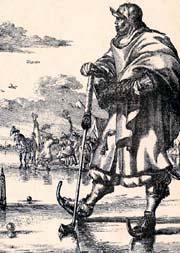Kolven
Sports like golf, croquet and hockey probably share the same roots: an old Dutch activity that was called ‘kolven’. The
 rules were simple: bring an
object from A to B by hitting it with a stick. Kolven can be seen in many pictures of the great Dutch 16th and 17th
century painters. Kolven was played in the streets and on the squares by
young and old and in winter time also on ice.
The play could be enjoyed in two ways. One possibility was to
position an object (often just a pebble) as close as possible near a target
rules were simple: bring an
object from A to B by hitting it with a stick. Kolven can be seen in many pictures of the great Dutch 16th and 17th
century painters. Kolven was played in the streets and on the squares by
young and old and in winter time also on ice.
The play could be enjoyed in two ways. One possibility was to
position an object (often just a pebble) as close as possible near a target (e.g. a tree, a wall or a drawn figure) by a single stroke. The other possibility was to move an object from A to B in as few
strokes as possible. The club consisted of a leaden shovel at a wooden stick. As the figure shows various sizes
(and weights) of shovels existed. In many towns kolven became a forbidden sport as the damage caused to windows
by flying objects was considerably. The resemblances with golfing are remarkably and both the play and its name could indeed be based on the old Dutch pastime of kolven.
(e.g. a tree, a wall or a drawn figure) by a single stroke. The other possibility was to move an object from A to B in as few
strokes as possible. The club consisted of a leaden shovel at a wooden stick. As the figure shows various sizes
(and weights) of shovels existed. In many towns kolven became a forbidden sport as the damage caused to windows
by flying objects was considerably. The resemblances with golfing are remarkably and both the play and its name could indeed be based on the old Dutch pastime of kolven.Bandy
It is known that though (field) hockey was played widely in the 19th century in England there were no uniform rules. Transferring field hockey to ice surfaces therefore must have been a small step for playful spirits. It was called bandy at first after a ball game of Scottish origin that seems to have had something in common with ‘polo’ but without the use of horses. Anyway, apart from England it seems to have been a popular pastime in the Scandinavian countries and Russia as well but as often the real history is a mystery. Maybe the play has never gained international allure since large ice surfaces were needed and they would need to be available for a considerable time to enable the organisation of some competition.
Ice hockey
It was the Canadians who ‘diminished’ bandy at the end of the 19th century
to the modern form of ice hockey that is played in relatively small indoor ice rinks.
Hockey skates
No doubt the early forms of ice hockey have been played on wooden ice skates. But we lack pictures to say something about their appearances. Since ice hockey players must be able to stop and turn abruptly the ice skates had to be fastened to the boots very well. It was the Canadian Forbes who designed the first
full metal ice hockey skates with a clamping system. They were made by the Halifax metalworking company from 1888. In the beginning of the 20th century when the Norwegian system with hollow tubes became popular the clamping systems disappeared and the boots were screwed to the ice skates.
Modern ice hockey skates have shoes and blades that are completely integrated.

English handbook for
ice hockey

Canadian Halifax skates
with clamping system

German hockey skates with one hand tightening system

traditional model
with tubular frame

modern model with frame of synthetic material
© 2002-12 The virtual Ice Skates
Museum. All rights reserved.
home |
sitemap |
copyright |
contact